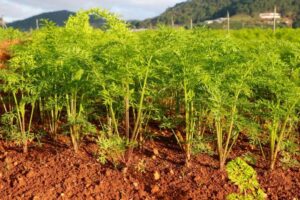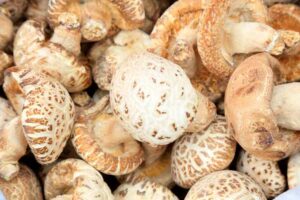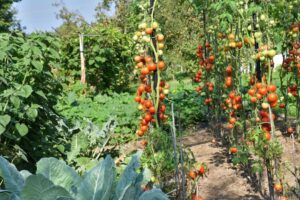
Iowa’s climate allows for growing lettuce throughout most of the year. However, certain times of the year are better suited for planting lettuce than others.
Today, we will discuss the ideal planting windows for different types of lettuce in Iowa and provide a step-by-step guide to successful lettuce growing.
1. Early Spring Planting (March-April)
For most areas of Iowa, one of the best times to start lettuce from seed is in early spring from mid-March through April. The soil and air temperatures are beginning to warm up after winter, but cooler weather persists. This moderate temperature is well-suited for germinating and developing lettuce seedlings.
Some varieties that do well with early spring planting include:
- Buttercrunch Lettuce: A butterhead type with soft, tender leaves. Slow to bolt.
- Bibb Lettuce: Also known as limestone lettuce. Forms tight, tender heads. Slow bolting.
- Red Salad Bowl Lettuce: A loose-leaf variety with reddish-purple leaves. Very winter hardy.
- Tropicana Lettuce: A romaine type with an upright habit. Frost tolerant.
When planting lettuce in early spring, start seeds indoors 2-3 weeks before the last expected frost date. Sow seeds 1/4-inch-deep in seed starting mix.
Provide grow lights for 16 hours of light per day and keep the soil moist and between 60-75°F.
Once seedlings have 2 true leaves, begin hardening them off for outdoor transplant. Wait for daytime temperatures to stay above 50°F before planting seedlings in the garden.
Space transplants 12-18 inches apart in rows 1 foot apart. Water daily for the first week as roots are established.
2. Mid-Spring Planting (Late April-May)
For most gardeners in Iowa, mid-spring is considered the prime time to direct sow lettuce seeds outdoors. Soil temperatures have warmed into the 40s-50s°F range, providing suitable germination conditions. Days are getting longer and warmer.
Some good varieties for mid-spring planting include:
- Leaf Lettuce: A looseleaf type with red or green leaf coloring. Bolt resistant.
- Grand Rapids Lettuce: Forms loose heads. Slow bolting.
- Salad Bowl Lettuce: Looseleaf type with red or green leaves. Easy to grow.
To Direct Sow Lettuce in Mid-Spring:
- Work the soil to a fine, moist seed bed and rake smooth.
- Create shallow 1/4-inch-deep furrows along planting rows spaced 1 foot apart.
- Sprinkle lettuce seeds thinly in furrows at a rate of 1/2 tsp per 10 ft row.
- Lightly cover seeds with soil and firm soil with hand or gentle watering.
- Space rows 1-2 feet apart depending on variety.
- Keep soil consistently moist until seeds germinate in 7-14 days.
- Thin seedlings or transplant excess to 4-6 inches apart when true leaves form.
4. Late Summer/Early Fall Planting (August-September)
For gardeners wanting an extension of their lettuce harvest into fall, a third planting time is late summer from August into early September. Daytime temperatures are still warm but nighttime lows have begun to cool into the 50s. This change in temperatures triggers lettuce to form heads and bolting is less likely.
Good bolting-resistant varieties include:
- Green Ice Lettuce: Romaine type with an upright habit and lime green leaves. Bolt resistant.
- Oakleaf Lettuce: Looseleaf type with oak-shaped leaves. Slow to bolt.
- Babyleaf Red Salad Bowl: Looseleaf mix grows quickly for baby greens.
The planting and care of late summer lettuce is similar to the spring instructions. Sow seeds 1/4 inch deep, thin seedlings as needed, and water regularly to avoid drying out in heat.
A mulch of grass clippings helps conserve moisture. Pick outer leaves regularly for continuous baby lettuce harvest into fall.
Step-by-Step Lettuce Planting Guide:
Step 1: Till, rake, and break up any clumps 4-6 weeks before planting. Compost or fertilize if needed.
Step 2: Select a type suited to the season based on bolting resistance, maturity, and your taste preference.
Step 3: For very early spring, begin 2-3 weeks before the last frost under the grow lights.
Step 4: Gradually expose seedlings to outdoor temps over 7-10 days before planting in the garden.
Step 5: Use furrows or scatter seeds evenly over the prepared soil row at 1/2 tsp per 10 ft. Press soil lightly to cover.
Step 6: Keep soil consistently moist until seeds sprout in 7-14 days or until rains. Water deeper but less often when sprouted.
Step 7: After true leaves form, thin plants stand 4-6 inches apart with scissors or by gentle pulling of excess seedlings.
Step 8: Optional. Spread 2 inches of straw, and grass clippings around plants to conserve moisture and suppress weeds.
Step 9: Side dress with compost tea or balanced fertilizer 4-6 weeks after planting to boost growth.
Step 10: Check regularly for pests like slugs, aphids, and diseases. Remove affected leaves or use approved organic controls.
Step 11: For cut-and-come-again, pick outer leaves when young and tender. For heading types, harvest the entire plant before the flowering stalk forms.
Step 12: Make additional plantings every 2-3 weeks for continuous lettuce harvest all season in spring, summer, or fall.
Conclusion
With the right variety selection and planting method, home gardeners in Iowa can enjoy fresh, local lettuce from their garden beds throughout much of the year. Following these guidelines will help you maximize quality lettuce production based on your region’s growing seasons. Happy eating!







